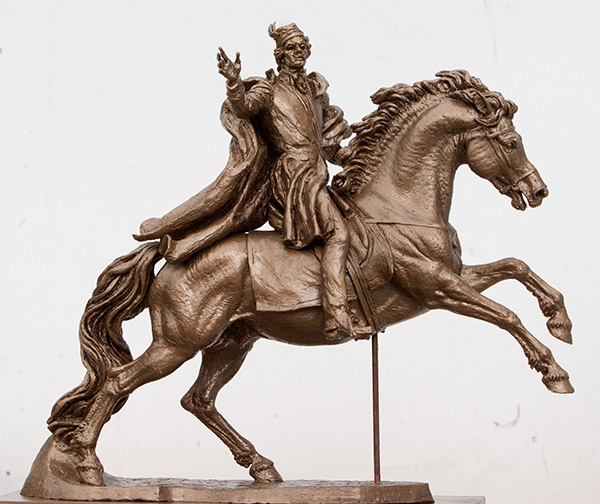
Sergey Bondarenko with his sculptural compositions ‘Clown on the Trumpet’ and ‘Clown with a Drum’
“This composition isn’t being made ‘to order’,” admits Sergey. “I’m a personal admirer of Kosciuszko’s life, and hope that this image of the hero will inspire a street to be named after him, or for there to be a future commission for a monument, probably depicting him as a horseman.”
Sergey began designing a sculpture for placement near the circus without waiting for a commission, having been inspired by the theme. “I have no idea where that inspiration suddenly came from but, later, I received a proposal from circus heads and the circus architect. By the time I signed the agreement, I already had my horse designs ready,” he adds.

‘Hospitable Belarus’
|
These bronze circus artistes have no prototype, having been born from his imagination. “Many think, for some reason, that the sculpture depicts real circus tricks. However, that wasn’t my goal: I’m not an expert. We wished simply to create the circus atmosphere and play with popular motifs. I look at the reaction of those driving past and see them taking photos. Pedestrians rub the noses of the sculptures for luck, which is wonderful. Art should be accessible to everyone, forging a relationship, so that people claim it for their own.”
Mr. Bondarenko is known for being fond of creating horses in his works, having loved these graceful, noble animals since childhood. “In summer, I used to visit my granny’s village home in the Pukhovichi District and would always run to see my beloved horses in the stables. Later, I began to professionally sculpt them, studying equine anatomy, to correctly depict all the muscles of this beautiful creature. Before sculpting, I spend time observing them, so that I can take note of their particular features. I take photos, or work as I watch them. I still remember the names of all the horses I’ve worked with,” Mr. Bondarenko emphasises.
Famous horse Ratina, named as one of the world’s top sporting horses for several years in a row, is among Sergey’s ‘models’. He’s also sculpted famous horsewoman Inessa Poturaeva, on her horse. He admits that orders have been declining in number, although people do order them as gifts — especially for official business trips. He blames the global crisis, which has reduced the number of foreign exhibitions and horse fairs organised as part of world championships.

‘Kosciuszko’ sculpture
Sergey’s workshop is filled with equine heroes and their owners, including three depictions of Vitebsk’s Duke Olgerd. Sergey tells us, “This was my first horse monument, sculpted in just eight months, which is incredibly short. It’s not an exact description of Olgerd’s face. Rather, I used my imagination, based on my experience. I placed a falcon in his hand, as a message from the past to us, his descendants.”
At present, the master is assisted by his son Matvey, who is well known to all Minsk party-goers, having been a member of the band No Comment. In 2014, he took part in the national Eurovision selection round but he now focuses on sculpting. Among his recent projects is his work on the ‘Hospitable Belarus’ composition, installed near the Palace of Independence.
By Yulia Leonova











